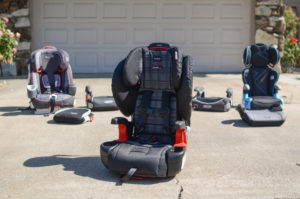 “I’ve got shotgun!”
“I’ve got shotgun!”
“No, I’ve got shotgun!” argued my 11-year-old son and his 11-year-old friend. One boy is short for his age; the other is close to 5 feet tall. Can either of them safely sit in the front seat?
As a new or expectant parent, we are often fixated on our infant’s car safety seat. As our children grow, and grow at different rates with different body types, how do we decide the safest solution for their evolving needs? When can they transition from a five-point restraint to a booster seat? When can we stop lugging the booster seat to every event and play date? When can they safely sit in the front seat?
For those of us who shuttle children on a regular basis, it can be difficult enough to make sure everyone in the car has shoes and doesn’t need the restroom two blocks into the ride. So it can be even more challenging to take the extra time necessary to use the appropriate level of car restraint. The following statistics, however, should give all who transport children renewed urgency about car restraint guidelines.
Every hour, nearly 150 children between ages 0 and 19 are treated in emergency departments for injuries sustained in motor vehicle crashes. More children ages 5 to 19 die from crash-related injuries than from any other type of injury.
– Centers for Disease Control
Imagine five school busses full of children taken to the emergency department per hour, every hour. Five bus loads of injuries that could largely be prevented by using appropriate restraints.
What’s more, a recent analysis in the Journal of Pediatrics found that 43 percent of children who died in car accidents were either not buckled in appropriately or not buckled at all.
Being a mother of five children, I know how tough the juggling act can be. But reading those statistics reminds me that properly restraining my children in my car is more important than anything else going on at the time. I may feel bad about being a few minutes late to the next event, but I’ll never regret taking the time to ensure their safety on the way.
With that in mind, here are the most recent car restraint guidelines for your kids. I recommend using the American Academy of Pediatrics’ guidelines over state-issued ones, as the AAP tends to update them more frequently.

Car Restraint Guidelines:
American Academy of Pediatrics (reconfirmed in 2017)
- Infants up to toddlers age 2: Rear facing or rear-facing convertible car seats should be used until child reaches the weight and height limits of the car seat. These seats should always be placed in the back seat.
- Children over the age of 2 or who have outgrown their rear-facing car seat can be transitioned into a forward-facing car seat. They should remain there as long as possible until the child reaches the height and weight limits of the car seat (some car seats can accommodate up to 65 to 85 pounds).
- Belt positioning booster seats are the next step. It is critical that the strap belt fall across the child’s chest and lap belt sits across upper thighs (not stomach). If your child cannot achieve this, he/she is not large enough to transition from forward-facing car seat.
- When the child is ready for a seat belt only, again proper positioning is key. The shoulder belt needs to rest across your child’s chest and lap belt across upper thighs. Also, the child’s back needs to rest comfortably on the back of the seat with knees bent easily at the edge of the seat. Usually, children need to be 4 feet 9 inches tall AND between 8-12 years of age.
- All children under the age of 13 need to sit in the back seat. Airbag deployment on a smaller body can cause serious injury or death.
Other important pieces of the child car restraint puzzle include purchasing the actual car seat, registering the seat in case of recalls, and then learning how to install and use it properly in your car. I have included some links and information to help below.
So did I let either my 11-year old son or his tall 11-year old friend sit in the front seat? Despite loud protestations declaring their advance maturity, the answer was no.
They will just have to wait a few more birthdays….
Some helpful resources:
1. Purchasing a car seat
Ease-of-use rating from the National Highway Traffic Safety Administration:
2. Registering a car seat for recall notification
Some of the main car seat manufacturers’ online registration forms:
- Alpha Elite or Alpha Sport
- Baby Trend
- Britax
- Chicco
- Clek Inc.
- Combi
- Cosco
- Compass
- Dorel
- Eddie Bauer
- Evenflo
- The First Years
- Graco
- Harmony
- Orbit Baby
- Peg Perego
- Safety 1st
- Radian
- RECARO
- Regal Lager
- Sunshine Kids
- Summer
You can also mail in your registration. Send a note to the manufacturer with:
- Your name
- Your current mailing address
- Manufacturer’s name
- Date of manufacture
- Model number
- Model name
If you do not have the manufacturer’s address, you can send your registration directly to the National Highway Traffic and Safety Administration and they will forward to the appropriate company:
U.S. Department of Transportation, National Highway Traffic Safety Administration Office of Defects Investigation, Correspondence Research Division (NVS-216)
Room W48-301, 1200 New Jersey Avenue S.E., Washington, DC 20590
They also have a registration form you can print out and use.
3. Making sure your car seat is installed and used correctly
You can schedule a hands-on safety check through the National Child Passenger Safety Certification Program:
